
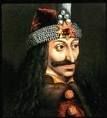
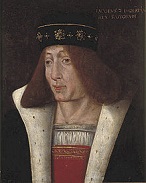








1460 About this year the Sporer (Spörer) Minimum begins (ends 1550), a 90-year span of low solar activity first proposed in 1976 by John A. Eddy based on analysis of C-14 in tree rings, and named for German astronomer Gustav Sporer. On Mar. 5 after Duke Adolf of Schleswig-Holstein died last year without heirs, and his nephew (son of his sister), Danish king (1448-81), Norwegian king (1450-81), and Swedish king (1457-64) Christian I (1426-81) of Oldenburg calls the nobles of Schleswig-Holstein to Ribe (Ripen), they elect him duke of the German province of Holstein, and duke of the Danish province of Schleswig (first succession in the female line); in return, he issues the Treaty of Ribe (Ripen), promising that Schleswig and Holstein will be forever undivided and autonomous under the crown of Denmark, which can never annex them, and that only his male heirs will be eligible for election as duke; since Schleswig is already a fief under the Danish crown, the Danish king becomes his own vassal?; from now on Schleswig is excluded from Danish laws, allowing German administrators to begin moving into S Schleswig, followed by German settlers, confusing things more. Fiery face gets fire in the face? In the summer the Scots siege English-held Roxburgh Castle on the Scottish border; too bad, on Aug. 3 29-y.-o. Scottish king (since Feb. 21, 1437) "Fiery Face" James II (b. 1430) (the original Flying Tomato?) is hoist by his own petard, i.e., killed by his own siege gun, the Mons Meg (acquired from Philip the Good of Burgundy in 1457) after it explodes and a metal fragment severs his thigh and he dies of shock and blood loss (*!?! blasted newfangled devices?); "Red" Douglas, 4th earl of Angus is also wounded; on Aug. 10 after the queen races with him from Hume Castle to Roxburgh to encourage the disenhearted army, James II's 8-y.-o. son James III (1452-88) is crowned king of Scotland (until June 11, 1488) at Kelso Abbey by Red Douglas, with James II's widow Mary of Guelders (Gueldres) (1434-63) appointed as regent; he goes on to become the first Renaissance monarch in Scotland, not really, he proves ineffective and unpopular, and gets too chummy with England; Roxburgh is then taken by storm and raised, and no English POWS are taken. In June Richard Plantagenet, 3rd Duke of York (1411-60) and his Yorkists leave France, land in Sandwich, Kent on June 26, raise an army and enter London on July 2 and siege the Tower, then send an army under the Duke of Buckingham and "kingmaker" Richard Neville, 6th Earl of Salisbury and 16th Earl of Warwick (1428-71), eldest son of Richard Neville, 5th Earl of Salisbury and 14th Earl of Warwick (1400-60) to meet Henry VI on July 10 at the Battle of Northampton; after treachery by Lord Grey of Ruthven, the Yorkists kill Buckingham, capture Henry VI and take him back to London, where they force him to acknowledge Richard Plantagenet as heir to the throne (bypassing Henry's son Edward), and he names Richard Neville as chamberlain of England, and his youngest son George Neville (1432-76) as chancellor (until 1467); too bad, Queen Margaret of Anjou isn't amused about her son being bypassed, and raises an army in Scotland against him. On Dec. 25 Pope Pius II excommunicates Sigismondo Malatesta (1417-68) of Rimini, accusing him of incest, sodomy et al. as well as treachery against Duke Federico da Montefeltro of Urbino over Siena, soiling his rep. for cents.; papal forces then begin a siege on his territories (ends 1463), leaving him only Rimini and a 5-mi. buffer zone. On Dec. 30 the Wars of the Roses sees a Lancastrian V at the Battle of Wakefield on Wakefield Green near Sandal Castle; badly outnumbered Richard of Plantagenet, 3rd duke of York (b. 1411) is KIA, and his head is proudly displayed on the city walls of York wearing a paper crown; Richard's son Edmund is KIA, a nd another son Rutland is killed by Lord Clifford while fleeing; the earl of Salisbury is taken to Pontefract and beheaded; Warwick escapes, and with Richard's three remaining sons Edward, George (duke of Clarence), and Richard (two kings out of three ain't bad?) continue the Yorkist cause, keeping Henry VI in captivity in the Tower as insurance - violin crescendo please? Thurgau (Thurgovie) S of Lake Constance joins the Swiss Confederation. In this decade the Gaelic kingdom of Tyroconnell (Gael. "land of Conaill") is established by the O'Donnell (O Domhnall) Dynasty of the Northern Ui Neill, with capital at Donegal; the O'Donnell kings of Tyrconnell become known as the Fisher-Kings for their export of fish for wine in La Rochelle, W France; it is disestablished in 1607. It's kind of relaxing to get some fresh mountain air? Wallachian prince Vlad III Dracula (1431-76), who stopped paying tribute to the Ottomans last year makes an alliance with Matthias Corvinus of Hungary, pissing off the sultan, who tries to remove him and fails, pissing off Dracula, who plans a revenge tour, impaling 10K at the same time in Sibiu, Transylvania; meanwhile sultan Mehmed II conquers Patrasso and the Morea (Arcadia), the last Greek stronghold in the Peloponnesus, extending the Ottoman empire to the Aegean; Thomas Paleologos, last ruler of the Morea brings the alleged skull of St. Andrew from Patras to Rome; the (Famous) Klephts (Gr. "robbers"), Greek patriots fleeing into the massy mountains of Macedonia and N Greece after the Ottomans conquer Greece begin a 4-cent. guerrilla war, developing their own culture and lit. incl. cool ballads. Archduke Sigismund of Austria stinks himself up by imprisoning his rival Nicholas of Cusa, causing Pope Pius II to excommunicate him and place an interdict on his lands. Persian Safavid Sufi leader Shaykh Junayd dies, leaving his son Shaykh Haydar (-1488) ("lion") to carry on his holy war against the Christians in Georgia as new head of the Safavid order, based in Ardabil, which sends out Qizilbash (Red Head) recruits (based on a distinctive headgear invented by Haydar) to preach a message of revolution; Haydar marries a daughter of White Sheep ruler Uzun Hazan, but falls out with his successor Ya'qub (1481-90). Le Thanh-Tong (1442-97) becomes Le emperor of Vietnam, instituting reforms in land distribution and spiffing up the bureaucracy. Hans Rosenplut (Ger. "fly catcher") becomes one of the first mastersingers of Nuremberg. In 1460-1520 the Grands Rhetoriqueurs (Rhétoriqueurs) group of poets flourish in N France, Flanders, and the duchy of Burgundy, combining stilted language with the allegorical manner of the 15th cent. and the most complicated artificial forms of the ballade and rondeau, producing ostentatious poetry with extremely rich rhyme schemes that experiments with assonance and puns, alternation between masculine and feminine thymes (ending in a mute 'e'), and typography and graphic use of letters incl. verbal rebuses; leaders incl. Georges Chastellain (1415-74), Jean Marot (Jehan Desmaretz) (1463-1526), Jean Meschinot (1420-91), Jean Robertet, Guillaume Cretin (Crétin) (1460-1525), Jean Lemaire de Belges (1473-1525), Jean Bouchet (1476-1555), Andre (André) de La Vigne, Octavien de Saint-Gelais (1468-1502), Jean d'Auton, and Pierre Gringore (1475-1538). Mystishchi NE of Moscow on the Yauza River is founded, named after the duty paid by commercial ships to be hauled overland from the Yauza to Klyazama Rivers. Dominican Alanus de Rupe (1428-75) invents the myth of the Rosary of St. Dominic, backdating it to the year 1214. The U. of Glasgow is moved from its original site on Rottenrow to High Street until 1870, when it moves to Gilmore Hill. Scottish queen Mary of Guelders founds Trinity College Church in Edinburgh in memory of her hubby James II. Paduan painter Andrea Mantegna (1431-1506) moves to the fortified city of Mantua in N Italy (38 mi. N of Modena) on two islands formed by the Minco, and spends the rest of his life as court painter to three gens. of the ruling Gonzaga family, decorating Gonzaga Fortress with his paintings and making copper engravings. After being sent by Cosimo de'Medici of Florence to scour Euro monasteries in the Byzantine Empire for lost ancient mss., monk Leonardo da Pistoia (Leonaro Alberti de Candi) finds the 2nd cent. Corpus Hermeticum and gives it to Marsilio Ficino (1433-99) to be translated, reintroducing Hermeticism to the West. Architecture: The Greek Parthenon (built in 438 B.C.E.) is turned from a Christian church (since 426 C.E.) into a Muslim mosque. Art: Dirk Bouts (1410-75), Virgin (Madonna) and Child. Francesco Squarcione (1397-1468), Virgin and Child; his only signed painting, other than an altarpiece in Padua. Rogier van der Weyden (1399-1464), Descent from the Cross. Births: French gen. Louis II de La Tremoille (Trémoille) (Trimouille) (d. 1525) on Sept. 29 in Thouars. Italian painter Giovanni Donato da Montorfano (d. 1503) in Milan. German gothic sculptor Adam Kraft (Krafft) (d. 1508) in Nuremberg. Spanish gov. of Hispaniola (1502-9) Nicolas de Ovando y Caceres (Nicolás de Ovando y Cáceres) (d. 1518) in Castile; member of the Military Order of Alcantara. Scottish poet and Franciscan friar William Dunbar (d. 1520) in East Lothian; educated at St. Andrews U. Spanish conquistador-explorer Juan Ponce de Leon (León) (d. 1521) (b. 1474?) in Santervas de Campos, Castile; father of Juan Ponce de Leon II (1524-91). French regent Anne of Beaujeu (d. 1522); sister of Charles VIII of France; wife of Pierre de Bourbon. German sculptor Adolf Daucher (d. 1523). French artist Gerard David (d. 1523). Portuguese navigator-explorer Vasco da Gama, 1st Count of Vidigueira (d. 1524) in Sines (Vidigueira?), Alentejo; created count in 1499, becoming the first Portuguese count not born with royal blood. English humanist physician Thomas Linacre (Lynaker) (d. 1524) in Brampton, Chesterfield, Derbyshire; physician to Henry VII and Henry VIII, tutor to Princess Mary, and founder and pres. #1 of the College of Physicians. Italian Renaissance painter Vittore Carpaccio (d. 1526) in Venice; known for his pageant paintings. Spanish conquistador Rodrigo de Bastidas (d. 1527) in Triana, Seville. Portuguese diplomat-explorer Pero (Pedro) da Covilha (d. 1527) in Covilha, Beira. Spanish military engineer Pedro Navarro, Count of Oliveto (d. 1528) in Garde, Roncal, Navarre. English Renaissance humanist poet-dramatist-satirist John Skelton (d. 1529) in Norfolk. German sculptor Peter Vischer the Elder (d. 1529) in Nuremberg; son of sculptor Hermann Vischer the Elder (-1487). Italian "Anatomia Carpi" (Bolognese) physician-anatomist Jacopo (Giacomo) Berengario da Carpi (Carpus) (d. 1530) in Carpi, Modena; educated at the U. of Bologna. Lithuanian hetman (1497-1530) (Orthodox Catholic) Konstanty Iwanowicz Ostrogski (d. 1530); of Slavonic descent; speaks Ruthenian, father of the Belarusian language. Spanish politician-gen. Fadrique Alvarez de Toledo y Enriquez, 2nd Duke of Alba (d. 1531); eldest son of Garcia Alvarez de Toledo, 1st duke of Alba and Maria Enriquez de Quinonex. German Gothic sculptor Tilman Riemenschneider (d. 1531) in Heiligenstadt im Eichsfield, Thuringia. Italian Renaissance painter Lorenzo Costa (d. 1535) in Ferrara. Portuguese explorer Tristao da Cunha (Tristao d'Acunha) (d. 1540). Portuguese physician-writer (Jewish) Judah Abrabanel (Abarbanel) (Abravanel) (Leo Hebraeus) (Lepne Ebro) (d. 1535) in Lisbon; son of Isaac Abrabanel (1437-1508); court physician to Hernandez Gonzalo de Cordoba. Deaths: Italian humanist Guarino da Verona (b. 1374). Portuguese prince Henry the Navigator (b. 1394) on Nov. 13 in Sagres, Algarve. Dutch-Burgundian composer Gilles Binchois (b. 1400) on Sept. 20. English Yorkist leader Richard Neville, 5th earl of Salisbury (b. 1400) on Dec. 31 (KIA in the Battle of Wakefield). English Yorkist leader Humphrey Stafford, 1st duke of Buckingham (b. 1402) in July (KIA in the Battle of Northampton). English wannabe king Richard Plantagenet, 3rd duke of York (b. 1411) on Dec. 30 (KIA in the Battle of Wakefield). Scottish king (1437-60) "Fiery Face" James II (b. 1430) on Aug. 3 in Roxburgh Castle (fire in the face?). Bohemian religious reformer Peter of Chelchich (b. ?); founder of the Bohemian Brotherhood, which rejects subordination to Rome.


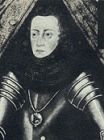
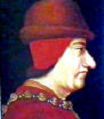
1461 In the winter of 1460/1 Vlad III Dracula crosses the Danube River and devastates the area between Serbia and the Black Sea, killing 20K, causing Sultan Mehmed II to plan a final invasion to kick his butt. On Feb. 2 a Yorkist army led by 19-y.-o. Edward Plantagenet, 4th duke of York, earl of Cambridge, and earl of Ulster, eldest son of deceased Duke Richard of York routs a Lancastrian army under the earls of Pembroke and Wiltshire at the Battle of Mortimer's Cross in Herfordshire; on Feb. 2 Catherine of Valois' secret hubby Owen Tudor (b. 1384) (founder of the Tudor Dynasty) is captured and beheaded on High St. in Hereford, expecting a reprieve because of his royal bed partner until the last moment, when he utters the soundbyte: "The head which used to lie in Queen Catherine's lap will now lie in the executioner's basket"; on Feb. 17 the Second Battle of St. Albans is a D for the Yorkists under Edward and Warwick, and Henry VI is freed, but the Lancastrians are not strong enough to take London, so they turn N, allowing the Yorkists to regroup, getting the Londoners to admit him to London; on Mar. 29 (Palm Sun.) the two rival kings meet at the Battle of Towton near York, and the Yorkists, led by the Earl of Warwick win after a snowstorm blinds the Lancastrian formation, becoming the biggest slaughter in English battlefield history; the first use of firearms on a British battlefield?; on June 28 Edward (who claimed to reign since Mar. 4) is crowned Edward IV (1442-83) (the 36th British monarch) (until Oct. 3, 1470) after Parliament deposes Henry VI on ?, declares the three Lancastrian kings usurpers, and Henry VI, his wife, son, and chief adherents traitors, and exiles him and his queen to Scotland; the Lancastrian Dynasty is supplanted by the York Dynasty; Edward IV closes a session of Commons with a speech of thanks, becoming the first time an English king addresses them; Edward IV creates his brother George as George Plantagenet, 1st Duke of Clarence (1449-78), and his other (youngest) brother Richard (future Richard III) as Richard Plantagenet, Duke of Gloucester (1452-85); Edward IV's cousin Richard Neville, 6th Earl of Salisbury and 16th Earl of Warwick (1428-71) is now the wealthiest and most powerful man in England, dictating much of his policy to the king and becoming virtual ruler (until 1464), later switching sides and becoming known as the kingmaker. In Mar. Scottish queen Mary of Gueldres secures the cession of Berwick to Scotland in return for sheltering fugitive Lancastrian king Henry VI and his queen Margaret of Anjou, although she switches to the Yorkist side. On July 22 Joan of Arc-aided king (since 1429) Charles VII the Victorious (b. 1403) dies, and his feeble, ungainly son Louis XI (the Spider) (1423-83) becomes Valois king #6 of France (until Aug. 30, 1483), perfecting Charles V's govt. system while traveling throughout his kingdom, his wimpy bod and bourgeois habits fooling people into underestimating this well-educated and brilliant diplomat who spins endless political webs, becoming France's last medieval king and the first Renaissance monarch; he immediately abandons his 18-y.-o wife Charlotte of Savoy in Burgundy (where they had lived in exile), leaving her to live off of Isabella of Bourbon; Flanders-born Tristan l'Hermite (-1478) becomes provost of the marshals of the king's household, giving him enormous power, causing him to later become a popular figure for novels and plays incl. Victor Hugo's "The Hunchback of Notre Dame", Sir Walter Scott's "Quentin Durward", Justin Huntly McCarthy's play "If I Were King", and Rudolf Friml's "The Vagabond King". On Sept. 23 after an insurrection by the Catalonians in his support, which forces John II of Aragon to release his son Prince Charles IV of Viana (b. 1421) from prison and finally recognize him as heir of Navarre as well as make him gov. of Catalonia in June, he dies within 3 mo. in Barcelona, causing a suspicion of poison by his mean stepmother Juana Enriquez of Castile (who has her son Ferdinand V waiting in the wings), triggering a series of revolts by his adherents in Catalonia; he had been betrothed to Catherine of Portugal, daughter of Duarte I. The Mainz Diocesan (Mainzer) Feud (Baden-Palatine War) begins when Adolf II of Nassau (1423-75) is declared archbishop of Mainz by Pope Pius II even though he lost an election in 1459 to Theodoric (Diether) of Isenburg-Budingen (1412-82), and the latter's followers won't accept him; Adolph Hitler, er, of Nassau wins next Oct. 28 after killing 400 and causing another 400 to flee (incl. Johannes Gutenberg), then revokes the imperial city status of Mainz; go figure, he recommends Theodoric as his successor - no wonder Germans go for Protestantism later? Ottoman Sultan Mehmed II conquers Anatolia as far as the Euphrates, incl. the Jandarid principality of Kastamonu and the last Byzantine possessions around Trebizond (Trabzon), incl. the Greek isle of Lesbos from the Genoese, where Byzantine historian Doukas lives, and where super Turkish adm. Barbarossa Hayreddin is later fathered by one of the Turkish knights, Yakup Aga; the Ottomans gain control of the Black Sea coast, but meet stiff resistance from the Mamlukes of Syria and White Sheep Turkmen of Iran - Muslims have a thing with colorful names? Hugh Roe O'Donnell (Aodh Ruadh mac Néill Gairbh Ó Domhnaill) (-1505) becomes king of Tyrconnell in Ulster, Ireland (until 1505); in 1468 guns are used for the first time in Ireland by his troops; the reigns of he and his son Hugh Duff O'Donnell become known as the golden age of the O'Donnells. Leonardo da Vinci becomes a pupil of Andrea del Verrocchio. French poet Francois Villon is arrested by order of the bishop of Orleans and imprisoned in Meung on the Loire River, then saved from the gallows after a few mo. by a gen. amnesty proclaimed by Louis XI in honor of his accession; he then vows to go straight and settles in Paris until Nov. 1462, when he is imprisoned in the Chatelet for theft, released, rearrested for a brawl, sentenced to death, jailed for more than a year, his sentence commuted to banishment from Paris, then in 1463 just disappears, becoming a legend, next popping up in Nevada in the 1961 Bonanza TV series episode The Frenchman? Architecture: The facade of the Oratorio di San Bernardino in Perugia (begun 1457) is finished. The Royal Library of France (Bibliotheque Nationale de France) is founded by Louis XI; in 1534 Francis I transfers it to Fontainebleau. Science: Regiomontanus retranslates Ptolemy's Almagest from Arabic to Latin; it is later used by Copernicus to refute Ptolemy. Poetry: Francois Villon (1431-63), Le Grand Testament (1461-2); his masterpiece?; 173 stanzas, incl. a bunch of rondeaux. Births: Lithuanian grand duke (1492-1506) and Polish king (1501-6) Alexander Jagiellon (d. 1506) on Aug. 5 in Krakow; 4th son of Casimir IV Jagiellon (1427-92). Spanish explorer (cmdr. of the Niña) Vicente Yanez Pinzon (Vicente Yáñez Pinzón) (d. 1515) in Palos de la Frontera, Castile; youngest son of Martin Pinzon and Mayor Vicente; brother of Martin Alonzo Pinzon (1441-93). Italian jurist Alessandro Alessandri (d. 1523) in Naples. Deaths: Portuguese House of Braganza founder Afonso I, 1st Duke of Braganza (b. 1377) on Dec. 15 in Chaves, Tras-os-Montes. Welsh Tudor Dynasty founder Owen Tudor (b. 1385) on Feb. 2 near Wigmore, Herfordshire (executed); last words: "The head which used to lie in Queen Catherine's lap will now lie in the executioner's basket". French king (1422-61) Charles VII the Victorious (b. 1403) on July 22 in Mehun-sur-Yevre. French poet Martin le Franc (b. 1410). Austrian astronomer (prof. at Vienna) George von Peuerbach (b. 1423) on Apr. 8 in Vienna. Spanish loser Charles IV of Navarre (b. 1426) on Sept. 23 in Barcelona (poisoned?).
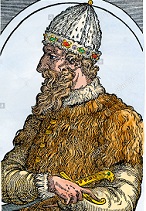
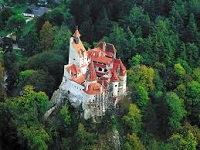
1462 On Mar. 27 grand duke (since Feb. 27, 1425) Vasilii (Basil) II (b. 1415) dies, and on Apr. 5 his son Ivan III Vasilievich (the Great) (1440-1505) becomes grand duke (prince) of Moscow in Russia, going on to unify the principalities of Russia around the nat. capital of Moscow and become Russia's first tsar (czar) (caesar); meanwhile serfs fleeing his oppression head to the Don River basin, becoming known as Cossacks. In the spring 90K Ottomans under Sultan Mehmed II invade Moldavia to finish off Vlad III Dracula, and run into 20K Turkish POWs being you-know-whated (impaled) outside his capital of Targoviste, capturing it on June 4, causing Dracula to resort to guerrilla war, sneaking into the Turkish camp on the night of June 16-17 in the Night Attack at Targoviste and trying to assassinate the sultan; after the sight of the horrible stake loads makes Mehmed too, er, II sick, he installs Vlad's younger half-brother Radu III the Handsome (cel Frumos)(1437-75) (who converts to Islam under the name Radu Bey) as prince, gains the support of the nobles (who know they are on the stake list anyway), then returns to Constantinople with his 3x-bigger army, leaving the job to Radu, who forces him to flee to guess where, Transylvania, after which his noble Transylvanian wife commits suicide during the seige of Dracula's Poienari Castle, throwing herself off a tower into a tributary of the Arges River later called Raul Doamnei (Lady's River) rather than be captured; in Aug.-Sept. as the Turks are closing in, Dracula sneaks out of his castle via an underground passage, then seeks help from Hungarian king Matthias Corvinus to reclaim his Wallachian throne, which is granted in 1476 after imprisoning him in Bran Castle in S Transylvania for 2 mo., followed by Buda, Hungary for 12 years (until 1474) to think about it (a deal with Mehmed II); actually he's only imprisoned until 1466, then converts (feigns conversion?) from Orthodox to Roman Catholicism and marries Matthias' cousin Ilona Szilagy (Jusztina Szilagyi de Horogszeg) (1454-97) and has two sons, Vlad Dracula IV and ?, who dies at a young age; meanwhile his son (by the 1st wife) Mihnea cel Rau (the Evil) (-1510) goes on to become prince of Wallachia in 1508-9 - you know your father doesn't approve of your dental plan? On Aug. 20 Castile takes Gibraltar from the Moors (who held it since 1333), this time for keeps; the 8th siege by either side since 1309. On Sept. 17 the Battle of Swiecin (Zarnowiec) is a V for the Poles under Piotr Dunin (1415-84) over the Teutonic army under Fritz von Raveneck. Archduke Albert VI sieges his brother HRE Frederick III in Vienna, then takes over Lower Austria. Pope Pius II abolishes the Hussite Compacta, and organizes a grand alliance with Burgundy, Venice, and Hungary to go on Crusade against the Turks. The Chimu-Inca War in Peru begins (ends 1476). Portuguese settlers found a settlement in the Cape Verde Islands off the W coast of Africa 400 mi. W of Dakar, Senegal, which they call Ribeira Grande, becoming the first permanent Euro settlement in the African tropics; Portuguese explorer Pedro de Sintra explores inland from Freetown Habor, naming the surrounding hill formation Serra de Leao (Sierra Leone) (Lion Mts.), AKA Sierra Leone, then goes on to explore the Benin Empire; in 1495 a fort and trading post are built in Freetown Harbor by Portuguese traders, which becomes a trading center for African slaves. The Jews of Frankfurt are walled-up in the Judengass, er, Judengasse ghetto, allowing the pop. to zoom from 260 in 1543 to 2.7K in 1613, causing the town council to set a pop. limit of 500 families in 1616, plus only 12 weddings per year. The Platonic Academy of Florence is founded in the Medici villa in Careggi, with Marsilio Ficino (1433-99) as headmaster #1 - why don't you just call it neo-paganism? The Worshipful Co. of Tallow Chandlers livery co. is founded in London by makers of cheap (animal fat) candles. The first cartoons were woodcut illustrations in Biblia Pauperum (Paupers' Bibles) in Bamberg, Germany by printing pioneer Albrecht Pfister (1420-66). Nonfiction: Johannes Fust acquires Gutenberg's workshop and prints a 48-line Bible. Art: Dirk Bouts (1410-75), Unknown Man. Births: German "Steganographia" polymath humanist Benedictine abbot Johannes Trithemius (Johann Heidenberg) (d. 1516) on Feb. 1 in Trittenheim, Trier; educated at the U. of Heidelberg; teacher of Heinrich Cornelius Agrippa (1486-1535) and Paracelsus (1403-1541). French Valois-Orleans king (1498-1515) and duke of Orleans (1465-1515) ("Father of the People") Louis XII (d. 1515) on June 27 in Blois; son of Duke Charles of Orleans (1394-1465) and Marie of Cleves (1426-87). Italian physician-philosopher (founder of the Aristotelean-Averroistic School) Pietro Pomponazzi (Petrus Pomponatius) (d. 1525) on Sept. 16 in Mantua; educated at the U. of Padua. German mathematician Johann Widmann (d. 1498). English soldier Edmund Dudley (d. 1510); father, by Elizabeth (daughter of Edward Grey, viscount Lisle) of John Dudley, earl of Warwick and duke of Northumberland (1502-53). Italian Renaissance painter Piero di Cosimo (Lorenzo) (d. 1521) in Florence; pupil of Cosimo di Lorenzo Filippi Rosselli (1439-1507). English dramatist Henry Medwall (d. 1522). Spanish (Castilian) princess Juana (Joanna) (the Beltraneja) (d. 1530); daughter of Princess Joana (1439-75) and Henry IV (1425-74); nicknamed Beltraneja from rumors that her really daddy is Castilian nobleman Beltran de La Cueva (1443-92).


1463 In the spring the Ottoman Muslims under Mehmed II invade Bosnia, killing Catholic king Stefan Tomasevic and capturing the country (until 1878); on May 28 Mehmed II grants the Ahdname (Charter) of Milodraz to the Bosnian Fransciscans in which he regulates their relationship with the Roman Catholic Church represented by the Bosnian custos Andjeo (Angel) Zvizdovic; Mehmet II erases all evidence of Bosnian statehood, destroying all 500 of its castles and forts and executing its nobility, then later importing elite Sephardic Jews after they are expelled from Spain in 1492, who convert to Islam in exchange for titles of nobility (bey and agha); Sarajevo (Turk. "saray" = palace) (modern-day pop. 275K/395K) on the Miljacka River in the Sarajevo Valley of the Dinaric Alps is founded by the Ottomans, becoming the capital of Bosnia and Herzegovina; Mehmed II's Bosnian conquests scare the Venetians into taking him on to protect their Aegean and Adriatic coastal possessions, and they begin the First Ottoman-Venetian War (ends 1479), seizing Morea (Peloponnesus), while the Hungarians retake Bosnia, only to see the Muslims retake it next year. To keep his scholarly brain around, fellow humanist Aeneas Silvius Piccolomini (Pope Pius II since 1458) gets Greek-born Cardinal Johannes (Basilius) (Basilios) (Viovanni) Bessarion (Bessarione) (1403-72) appointed Latin patriarch of Constantinople, and in Apr. he becomes dean of the Sacred College of Cardinals. In the summer after Bishop James Kennedy of St. Andrews puts Queen Mary of Gueldres up to it, a Scottish force unsuccessfully sieges Norham Castle, stronghold of the bishops of Durham; in Dec. Mary dies., and Kennedy becomes guardian of 11-y.-o. James III, and switches Scottish policy to Pro-French and pro-Lancastrian, only to see the Yorkists come out on top next year. HRE Frederick III recognizes Matthias Corvinus as king of Hungary, and in return the latter recognizes the Hapsburg claims to succession; meanwhile on Dec. 2 Frederick's brother Albert VI the Prodigal dies childless, allowing him to regain control of Lower Austria and unite it with Upper Austria; too bad, he stays above mere politics and lets the Bohemians and Hungarians plot to pick Austria apart without hindrance? Thomas FitzJames FitzGerald, 7th Earl of Desmond (-1468) becomes lord deputy of Ireland for the Duke of Clarence, founding the College of Youghal in 1464, becoming known for defending the native Irish against the cruelty of English law; too bad, in 1467 he is accused by his enemies of treason and extortion, and condemned at a parliament in Drogheda along with Thomas FitzGerald, 7th Earl of Kildare, who escapes to England while he is beheaded on Feb. 14, 1468, shocking the Irish people ("slain by the swords of the wicked, or may I say a martyr)", after which Kildare gets Edward IV to revoke their attainder; meanwhile in 1467 their worst enemy John Tiptoff, 1st Earl of Worcester (1427-70) (who conspired to get Desmond executed?) is appointed by Edward IV as lord deputy of Ireland in Desmond's place, becoming known as "the Butcher of England" for his ruthlessness and cruelty to the Irish. Muhammad III of Bidar (1454-82) conquers Konkan and Telingana in the Deccan of India to both coasts. Monte de Pieta in Orvieto, Italy begins the innovative practice of loaning money to poor people at low interest to undercut Jewish moneylenders. The U. of Bourges in France is founded by Louis XI, later producing John Calvin, Jacques Amyot, and Theodore de Beza; closed during the French Rev. (1789). The U. of Padua establishes a chair in Greek, starting with Demetrius Chalcondyles, a protege of Johannes Bessarion, who becomes the teacher of Thomas Linacre (physician of Sir Thomas More and Desiderius Erasmus), and leaves in 1473 to succeed John Argyropoulos (1415-87) (teacher of Johannes Reuchlin, Guillaume Bude, and Lefevre d'Etaples) in Florence; in 1473 Marcus Musurus ("greatest Hellenist of the Renaissance") succeeds to the Greek chair in Padua, becoming the teacher of Desiderius Erasmus. Architecture: The Mosque of Sultan Mehmed II the Conqueror in Constantinople is begun (finished 1470). The pointed Gothic Hotel de Ville in Louvain, Belgium (begun 1448) is completed. Nonfiction: Marsilio Ficino completes the first complete trans. of Plato's writings into Latin. Ulrich Zell (d. 1507) becomes the first printer in Cologne. Births: German Saxon elector (1486-1525) Frederick III (the Wise) (d. 1525) on Jan. 17 in Torgau; son of Ernst of Saxony (1441-86); big defender of the Protestant Reformation. Italian humanist philosopher Count Giovanni Pico della (de) Mirandola (d. 1494) on Feb. 24 near Ferrara; educated at the U. of Bologna. Italian anatomist Alexander Achillini (d. 1512); discoverer of Wharton's duct (entry of the bile duct into the duodenum), and the hammer and anvil bones of the middle ear. French poet Jean Marot (Jehan Desmaretz) (d. 1526) in Mathieu (near Caen); official poet of Louis XII and Francis I; father of Clement Marot (1496-1544). English churchman-diplomat Thomas Magnus (d. 1550). Deaths: Greek metropolitan Isidore of Kiev (b. 1385) on Apr. 27 in Rome. Spanish Franciscan missionary St. Didacus of Alcala (b. 14500) on Nov. 12 in Alcala de Henares; canonized in 1488 by Pope Sixtus V. Byzantine historian Doukas (b. 1400); leaves History, covering the years 1341-1462 incl. the 1389 Battle of Kosovo, the 1453 fall of Constantinople, and the 1462 capture of Lesbos. French queen (1422-63) Marie of Anjou (b. 1404) on Nov. 29 near Saint-Maxent, Deux-Sevres. Austrian archduke Albert VI (b. 1418) on Dec. 2. French poet Francois Villon (b. 1431); leaves Codicile (ballads), Le Jargon (ballads), Dialogue (between Mallepaye, AKA Pinchpenny and Baillavent, AKA Wastrel), The Free Archer (Le Franc Archier) (monologue). Scottish queen Mary of Guelders (b. 1434) on Dec. 1.





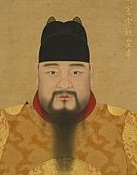


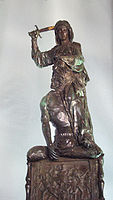
1464 On Feb. 23 Louis XI visits Philip III the Good of Burgundy in Lille to talk him out of going on the long-awaited Crusade against the Turks in order to stay and arrange a truce between France and England, and to back France if England wants war, with the promise of 10K French troops for a Crusade later; meanwhile on Apr. 20 and May 4 82 volunteers leave Ghent dressed in black with Crusader crosses on their chests and silver Gs on their backs, set sail from Sluis on May 21, and reach Marseille, only to learn of the death of Pope Pius II on Aug. 14 and turn back. On Feb. 23 emperor (since 1457) Yingzong (b. 1427) dies, and on Feb. 28 his eldest son becomes Chenghua ("accomplished change") (Zhu Jianshen) (1447-87), Ming emperor #8 of China (until Sept. 9, 1487), going on to let the eunuchs run all over him, increasing their numbers to 10K and taking over the palace admin. - where did all those balls go? On Apr. 25 after Margaret of Anjou invades England from Scotland with a Yorkist army, takes several castles, and is joined by Somerset and the Percies, she is defeated at the Battle of Hedgeley Moor S of Wooler in Northumberland by the Earl of Warwick's brother John Neville, 1st Marquess of Montagu (1431-71), who kills Sir Ralph Percy. On May 15 the Lancastrians are decisively defeated by the Yorkists, led by John Neville at the Battle of Hexham, for which he is created earl of Northumberland in 1467, resigning in 1469 in favor of restoring the Percies and receiving the title marquis of Montagu instead. On Aug. 1 Cosimo I de' Medici Vecchio (b. 1389) dies, and Florence declares him Pater Patriae (father of his country); his semi-invalid arthritic son Piero di Cosimo "the Gouty" (il Gottoso) (1416-69) takes over Florence (until Dec. 2, 1469). On Aug. 11 Nicholas of Cusa (b. 1401) dies in exile in Italy a few days after his enemy Archduke Sigismund finally capitulates and surrenders in order to receive a papal pardon. On Aug. 14 Pope (since 1458) Pius II (b. 1405) dies of fever in Ancona while sailing to the East still trying to organize a Crusade, and on Aug. 30 Pietro Barbo is elected Pope (#211) Paul II (1417-71) (until July 25, 1471), and all plans for a Crusade are dropped and never renewed. On Aug. 21 emperor (since 1428) Go-Hanazono (b. 1419) abdicates, and his eldest son Go-Tsuchimikado (1442-1500) becomes Japanese emperor #103 (until Oct. 21, 1500). On Sept. 7 Frederick II the Gentle (b. 1412) dies, and his two sons Ernest of Saxony (1441-86) and Albrecht III the Bold (1443-1500) decide to split Saxony, with Albrecht becoming duke and Ernst becoming elector. The earl of Warwick proposes a marriage between Edward IV and Bona of Savoy, Duchess of Milan (1449-1503), sister-in-law of Louis XI of France in order to ally the two countries and end the Lancastrian threat forever, and she accepts, then learns that in the meantime Edward IV has pulled a boner and in Apr. secretly married his candy britches dream girl (a commoner) Elizabeth Woodville (1437-92) (Lady Elizabeth Grey), recent widow (with two children) of the Lancastrian Sir John Grey of Groby (who died in battle in 1461), who was crowned queen in May; worse, she is the daughter of Richard Woodville (Lord Rivers), a Lancastrian; the new queen has 11 brothers and sisters, many of them married into the families of great nobles, creating a new nobility which weakens Warwick's influence with the king and making him jealous, while causing Edward's popularity with the older nobles to tank until Henry VI's 1471 death shuts them all up; to multiply Warwick's troubles, she later gives Edward 10 royal rugrats; meanwhile, despite Lady Bona's attempts to turn him against Edward, Louis XI sees the light and drops his support of his kinswoman, deposed Queen Margaret of Anjou, and seeks an alliance with Edward, which is welcomed by Warwick; George Neville, brother of the earl of Warwick, who had been rapidly promoted from chancellor of Oxford U. in 1453 to bishop of Exeter in 1458 to English chancellor in 1460 is appointed archbishop of York. An uprising in Sweden against Christian I Denmark kicks him out and invites exiled Karl Knutsson back. Sonni (Sunni) Ali Ber (-1492) becomes king #1 of the Songhai (Songhay) Empire in W Sudan incl. the Timbuktu-Gao region, with Gao as the capital, which grows too big to manage before being conquered by the Askiya Dynasty in 1493, and by Morocco in 1591. Louis XI France establishes a royal postal service. Inventions: Printing crosses the Alps to Italy. Art: Dirk Bouts (1410-75), The Last Supper (1464-7) (Church of St. Pierre, Louvain); first Flemish Last Supper painting; shows understanding of Italian linear perspective. Donatello (1386-1466), Judith and Holofernes (sculpture) (1457-64); one of the first Renaissance sculptures to be conceived in the round. Births: Spanish conquistador Diego de Nicuesa (d. 1511). Japanese emperor #104 (1500-26) Go-Kashiwabara (Katsuhito) (d. 1526) on Nov. 19; eldest son of Go-Tsuchimikado (1442-1500). Deaths: Italian godfather Cosimo I de' Medici the Elder (b. 1389) on Aug. 1 in Careggi - worrying about Jesus' parable about the rich man, camel and a needle? Flemish (Dutch) painter Rogier van der Weyden (b. 1399). German superbrain philosopher cardinal Nicholas of Cusa (b. 1401) on Aug. 11 in Todi, Umbria, Italy (in exile); leaves De Docta Ignoratia (Of Learned Ignorance), De Visione Dei (On the Vision of God), On Conjectures, Cribatio Alchorani (Sifting the Quran). Italian pope (1458-64) Pius II (b. 1405) on Aug. 14 in Ancona (fever). German elector Frederick II the Gentle of Saxony (b. 1412) on Sept. 7 in Leipzig. Spanish barren queen of Navarre (1461-4) Blanche II of Navarre (b. 1424) on Dec. 2 in Orthez, France (poisoned).



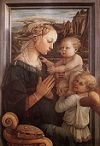
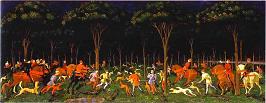
1465 On Mar. 15 English chancellor George Neville becomes archbishop of York (until 1476); in Sept. his enthronement in Cawood Castle shows off his family's grate wealth and powah, with 2.5K attending, incl. his family's 28 peers, 59 knights, 10 abbots, and 10 bishops, consuming 4K pigeons, 4K crays, 4K mallard and teal ducks, 4K cold and 1.5K hot venison pies, 4K dishes of jelly, 4K baked tarts, 2K hot custards, 2K pigs, 2K chickens, 1K sheep, 1K capons, 1K egrets, 500 stags, bucks and roes, 500 partridges, 400 plovers, 400 woodcocks, 304 calves, 204 cranes, 204 kids, 204 bitterns, 200 pheasants, 104 peacocks, 100 curlews, 200 dozen ruffs, 100 dozen quails, 400 swans, 400 herons, 113 oxen and 6 wild bulls, 608 pikes and bream, 12 porpoises and seals, 300 tuns of ale, 100 tuns of wine, etc. etc., not counting dessert - try singing that? On May 24 Bishop James Kennedy of Scotland dies, and a truce with England is negotiated; on Dec. 15 after 3.3K gold florins are paid by proctor Ricardo de Ricasolis of Florence, Pope Paul II makes his 30-y.-o. nephew Patrick Graham (1435-78) (bishop of Brechin since 1463) the bishop of St. Andrews, stirring resentment from his youth and inexperience and obvious nepotism. In Oct. after Louis XI's attempt to curb the power of the great nobles of Burgundy and Brittany and centralize his authority arouses the League of the Public Weal, headed by Charles the Bold and backed by Duke Francis II of Brittany, Louis grants the rebels' demands in the Treaty of Conflans and the Oct. 29 Treaty of Saint-Maur-des-Fosses. Ex-king Henry VI is captured and put in the Tower - out of sight, out of mind? Pope Paul II denounces the 1430s Council of Basel and the Compactata, excommunicates and deposes Hussite Bohemian King George of Podebrad, and enlists the aid of the HRE and King Matthias Corvinus of Hungary against him, causing the Roman Catholic nobles of Bohemia to elect Matthias as king, and a civil war to begin. New Catholic bishop (of Evreux) Jean Balue (1421-91) is appointed by Louis XI as his chief minister, getting a cardinal's hat in 1468. The Irish parliament passes an act requiring every Irishman living in the Pale to dress and shave like the English, and take an English surname such as a color, trade, or name of a town, else forfeit his goods; another act forbids fishing in Irish seas to prevent it from enriching the Irish people; another permits decapitating thieves found robbing "or going or coming anywhere" unless they have an Englishman in their company, with the mayor of the nearest town to pay head money. A Jewish pogrom in Fez, Morocco kills thousands, leaving only 11 alive. Sports: Edward IV passes an edict forbidding "hustling of stones" and other bowling-like sports. Architecture: The main part of the 700K-sq.-meter Topkapi (New) Palace (Yeni Saray) in Constantinople is finished, replacing the 1455 Old Palace (Eski Saray), becoming the official imperial Ottoman residence until the 19th cent. Inventions: The first printed music appears in ?. Printer Johann Fust of Mainz first uses Greek type. Art: Fra Filippo Lippi (1406-69), Madonna with Child and Two Angels. Antonio de Pollaiuolo, Battle of the Nudes (engraving) (1465-70). Paolo Uccello (1397-1475), The Hunt in the Forest (1465-70); uses Battista Alberti's method of perspective construction. Nonfiction: Maestro Martino de Rossi, The Art of Cooking; by the chef of the papal camerlengo (chamberlain), the patriarch of Aquileia; makes him the Western world's first celebrity chef?, marking the transition from medieval to Renaissance cuisine. Births: Italian mathematician Scipione del Ferro (d. 1526) on Feb. 6 in Bologna. Ottoman sultan #9 (1512-20) Selim (Arab. "peace") I (the Grim) (the Brave) (d. 1520) on Oct. 10 in Amasya; son of Bayezid II (1447-1512); father of Suleiman I (1494-1566). Spanish conquistador Alonso de Ojeda (Alonzo de Hojeda) (d. 1515) in Cuenca; starts out poor, then goes on Columbus' 2nd Voyage in 1493, accompanies Amerigo Vespucci in 1499, and makes money selling slaves. German painter Hans Holbein the Elder (d. 1524) in Augsburg, Bavaria; father of Hans Holbein the Younger (1497-1543). Spanish conquistador Diego Velazquez de Cuellar (Diego Velázquez de Cuéllar) (d. 1524) in Cuellar, Segovia, Castile. German painter Matthias Grunewald (d. 1528) in Aschaffenburg; court painter to Cardinal Albert of Brandenburg, elector of Mainz; known for paintings of the agony of Christ. Scottish philosopher-historian Hector Boece (Boyce) (Boise) (d. 1536) (AKA Hector Boecius or Boethius) in Dundee, Angus; educated at the U. of Paris. Russian abbot Philotheos (Philotheus) (Filofei)) of Pskov (d. 1542). Ottoman adm.-hero Piri Reis (d. 1554). Deaths: French poet Charles, duke of Orleans (b. 1391). Scottish noblewoman Mary Stewart, countess of Buchan (b. 1427) in the Netherlands. Scottish bishop (of St. Andrews) James Kennedy (b. ?) on May 24. Moroccan Marinid Sufi Berber leader (one of the seven saints of Marrakesh) Muhammad al-Jazuli (b. ?); leaves Dala'il al-Khayrat (Waymarks of Benefits) (prayer book).

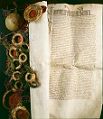
1466 On July 9 the Boyds of Kilmarnock, Kennedy clan rivals led by Robert Boyd, 1st Lord Boyd (-1482) and his younger brother Sir Alexander Boyd of Drumcol (1420-69) take custody of 14-y.-o. James III while out hunting near Linlithgow; Alexander then ditches Robert, becoming virtual ruler of Scotland (until 1469), getting his son Thomas Boyd created earl of Arran and married to James III's elder Mary, and his daughter Elizabeth Boyd married to Archibald Douglas, 5th earl of Angus, and putting himself in the office of chamberlain. In Aug. assassins almost kill Florence godfather Piero the Gouty, but his sons Lorenzo and Giuliano foil them, then seek to ally with military families outside Florence so it won't happen again. On Oct. 19 the Second Peace of Thorn (Torun) ends the Prussian Revolt (begun 1454), and establishes peace between Poland and the Teutonic Knights in Poland's favor, ending the German advance into Poland until the 18th cent. partitions; Poland secures West Prussia (Danzig, Kulm, Marienwerder, Thorn, Ermeland), Pomerania, and other territories (incl. Grodek); East Prussia is cut off from the rest of Germany, and Poland secures access to the sea; the Teutonic Knights retain East Prussia, with Konigsberg as capital, but it along with Brandenburg and Memel (modern-day Klaipeda, Lithuania) are held as Polish fiefs; the Teutonic Order is opened to Polish members, and begins its final slide - there goes the neighborhood? On Mar. 8 popular duke (since 1450) Francesco I Forza (b. 1401) dies, and his humanist-miseducated son Galeazzo Maria Sforza (1444-76) becomes too-cruel-to-be-kind-but-able-duke of Milan (until 1476), going on to become a patron of music, building up a chapel with one of the top musical ensembles in Europe, then stinking himself up with his horrible cruelty, having a man nailed alive to his coffin, starving a priest to death, and making a poacher swallow his catch (a hare) intact to kill him. Mehmed II occupies part of Albania (until 1468). Nonfiction: Johann Mentel prints the first German Bible in Strasbourg. Births: English queen consort (1486-1503) Elizabeth of York (d. 1503) on Feb. 11 in Westminster; eldest child of Edward IV (1442-83) and Elizabeth Woodville (1437-92); sister of Edward V (1470-83); niece of Richard of Gloucester (Richard III) (1452-85); wife (1486-1503) of Henry VII (1457-1509); mother of Arthur Tudor (1486-1502), Margaret Tudor (1489-1541), Henry Tudor (Henry VIII) (1491-1547), and Mary Tudor (1495-1533). Italian ruler of Mantua (1484-1519) Francesco II (IV) Gonzaga, Marquess of Mantua (d. 1519) on Aug. 10 in Mantua; son of Marquis Federico I Gonzaga (1444-84); father of Francesco II Gonzaga (1466-1519). Dutch "The Praise of Folly" Renaissance humanist Roman Catholic priest-scholar-theologian ("Prince of the Humanists") ("Crowning Glory of the Christian Humanists") Desiderius Erasmus (Lat. "beloved longing") Roterodamus (of Rotterdam) (Gerrit Gerritszoon) (d. 1536) on Oct. 27/28 in Rotterdam; educated at College de Montaigu, and U. of Turin; founder of Humanism, first Humanist to earn a living by writing, and first scholar to divide the Bible into verses; illegitimate son of Margaret (-1483), daughter of a physician; educated by the Brethren of the Common Life and at the U. of Paris; becomes an Augustinian priest in 1492; helps launch the Protestant Reformation but never joins it. Italian Venetian politician-diarist Marino Sanuto (Marin Sanudo) the Younger (d. 1536) on May 22 in Venice. Deaths: Italian sculptor Donatello (b. 1386) on Dec. 13. German pub. Johann Fust (b. 1400) in Mainz. Italian duke of Milan (1450-66) Francesco I Sforza (b. 1401) on Mar. 8 in Milan. German printer Albrecht Pfister (b. 1420) in Bamberg.

1467 In Mar. the Onin War (ends 1477) in Japan begin as the 260 daimyos come unglued, and Japan descends into sengoku jidai (gen. warfare) for 10 years. On June 15 Philip III the Good (b. 1396) dies, and his son Charles the Bold (1433-77) becomes the last reigning duke (Jan. 5, 1477) of (not Bar, not Berry, but) Burgundy, which controls the Low Countries and other territories as well, and is a rival to Louis XI of France; the Cent Nouvelles Nouvelles (Hundred New Short Stories), a collection of bawdy stories exchanged by Philip III the Good and his courtiers is left to posterity, and ed. by Antoine de la Sale (1385-1461), becoming the first work of lit. prose in French; Charles the Bold forms a new league against Louis XI with Francis II of Brittany and Edward IV of England, which incl. the marriage of Edward IV's sister Margaret to Charles; Francis II invades Normandy; the earl of Warwick balks at the betrayal of Louis XI, switches sides, allies with Lancastrian Queen Margaret, and retires to his estates to nurse plans for a rebellion. On Dec. 15 the Battle of Baia in Romania is a big D for the Hungarians under Matthias Corvinus against the Moldavians under Stephen III the Great, after which the Hungarians give up on subduing them. Casimir IV calls the first Polish Diet - high cholesterol? Karl Knutsson is recrowned king of Sweden, pissing-off Christian I of Denmark, who confiscates the estates of the Thott family in Gothland and Scania, coincidentally helping him pay the loans on Schleswig-Holstein. The White Sheep (Aq-Qoyunlu) under Uzun Hasan defeat their Tabriz-based rivals the Black Sheep (Qara-Qoyunlu) under Sultan (since 1437) Jahan Shah (b. 1397), who is KIA in Tabriz, ending the Baharlu (Barani) Black Sheep Dynasty; the White Sheep go on to occupy Iraq and W Iran. The Turks conquer Hum, and rename it Hercegovina (Herzegovina) - it's here, go find it? The weakening Hanseatic League breaks out into rivalry between Cologne and the Westphalian towns on one side and Danzig and the Prussian towns on the other. The Moravian Synod picks three elders, a bishop, and two presbyters by lot, and receives ordination from Waldensian bishop Stephen. Sports: The Scottish Parliament decrees that "fute-ball and golfe not to be used". Inventions: The first cast iron Hand Grenades appear in Europe. Music: Anon., William Tell (1467-76); the first ballad about the Swiss nat. hero. Births: Polish king and grand duke of Lithuania (1506-48) Sigismund (Zygmunt) I Stary (the Old) (d. 1548) on Jan. 1 in Kozienice; son of Casimir IV Jagiellon and Elisabeth of Austria Hapsburg; brother of John I Albert (1459-1501) and Alexander Jagiellon (1461-1506). French #1 scholar Guillaume Bude (Budé) (Budaeus) (d. 1540) on Jan. 26 in Paris; royal librarian under Francis I. English Renaissance humanist churchman (dean of St. Paul's from 1505) John Colet (d. 1519) on in Jan. in London; eldest son of Sir Henry Colet (lord mayor of London); educated at Magdalen College, Oxford U. Italian Lombard painter Giovanni Antonio Beltraffio (Boltraffio) (d. 1516) in Milan; pupil of Leonardo da Vinci, later causing experts to confuse their paintings. Portuguese navigator-explorer (discoverer of Brazil) Pedro Alvares (Álvares) (Alvarez) Cabral (d. 1520) (b. 1468?) in Belmonte. Spanish gen. Ramon Folc de Cardona i Anglesola, Count of Oliveto (d. 1522) in Bellpui, Aragon. Italian sculptor Andrea Contucci dal Monte Sansovino (d. 1529) in Monte San Savino (near Arezzo); pupil of Antonio Pollaiuolo; teacher of Jacopo Sansovino. Scottish philosopher-historian-theologian John Major (Mair) (Joannes Majoris) (Haddingtonus Scotus) (d. 1550) in Gleghornie (near North Berwick); grows up in Haddington, East Lothian; educated at the U. of Paris. Deaths: French duke of Burgundy (1419-67) Philip III the Good (b. 1396) on June 15 in Bruges, Flanders.
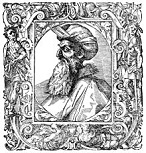

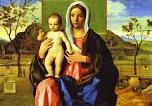

1468 On Jan. 17 Albanian hero Scanderbeg (b. 1405) dies, after which the Ottomans move in on Albania and force the pop. to convert to Grand Slam Islam, causing many Christian (mainly Greek Orthodox) Albanians and Arvanites (Albanian-speaking Greeks) to settle in S Italy, becoming known as the Abereshe (Arberesh); the mother of U.S. entertainer Regis Philbin (1931-) is an Abereshe? Louis XI invades and subdues Brittany, and forces Francis II to sign the Peace of Ancenis; taken POW by Duke Charles the Bold of Burgundy at Peronne, Louis XI is forced to sign a treaty with him; meanwhile Edward IV of England is kept busy repressing Lancastrian plots stirred up by Louis XI, while the earl of Warwick plots to dethrone him. 14-y.-o. Ferdinand II of Aragon (the Catholic) (b. 1452) is crowned king of Sicily, and spends his teens fighting in the Castilian wars. Sonni Ali, ruler of Songhai in Africa captures Timbuktu. Sejo dies, and Yejong II (d. 1469) becomes Yi king of Korea. Abu'l Khair dies, and his grandson Muhammad Shaybani (1451-1510) becomes ruler (khan) of the Uzbeks (Uzbegs). Circassian ex-slave Qaitbay (Al-Ashraf Sayf ad-Din Q'ait Bay) (1416-96) becomes sultan #18 of the sagging Mamluk empire (until 1496), going on to stabilize the economy, consolidate the N boundary with the Ottoman Empire, and become a great patron of art and architecture, fighting 16 military campaigns while building spectacular projects in Mecca, Medina, Jerusalem, Damascus, Aleppo, Cairo, and Alexandria, becoming infamous for building a fortress on the remains of the Lighthouse of Alexandria in 1480. The Ottomans conquer the principality of Karaman in C Anatolia, and for many years pretenders to the throne stage revolts - you think I kara, man? Christian I of Denmark calls the first-ever assembly of the estates of the realm; the Treaty of Denmark betrothes James III of Scotland to Margaret of Denmark, daughter of Christian I of Denmark and Norway; Scotland acquires the earldom of Orkney and lordship of Shetland from Norway as her dowry after the poor king can't pay the cash, then annexes them in 1472. Edward IV seeks to increase the number of cases of riot and violence brought before the court of star chamber. The bishopric of Vienna is established. The seaport of Anfa (Casablanca) in Morocco is destroyed by 10K Portuguese on 50 ships as a reprisal for piracy; they destroy it again in 1515. Dirk Bouts (1410-75) becomes the town painter of Louvain in C Belgium. Two men are called before the Archduchess Mechthild in Rotenburg, Germany for stealing the butcher's Rottweiler dog. Architecture: Andrea del Verrocchio makes a famous candelabra for the town hall of Florence, which ends up in Amsterdam and survives to modern times. The Cathedral of St. Elizabeth in Kosice, Slovakia (begun 1270) is finished. Art: Giovanni Bellini (1428-1516), Madonna and Child. Births: English grammarian (first headmaster of St. Paul's School, London) William Lily (Lilye) (d. 1522) in Odiham, Hampshire; educated at the U. of Oxford; first to teach Greek in London. Italian pope (1534-49) Paul III (Alessandro Farnese) (d. 1549); brother of Pope Alexander VI's mistress Giulia Farnese. Italian (Genoese) adm.-statesman Andrea Doria (d. 1560) in Oneglia. Deaths: Italian painter Francesco Squarcione (b. 1397) in Padua. German Great Man Who Invented Printing (And Made Bill Gates Possible) Johannes Gutenberg (b. 1398) on Feb. 3 in Mainz. Ethiopian emperor (1434-68) Zara Yaqob (b. 1399). Albanian anti-Ottoman resistance leader Prince Scanderbeg (b. 1405) on Jan. 17. Italian ruler Sigismondo Malatesta (b. 1417) on Oct. 7 in Rimini; dies after fighting for Venice against the Ottomans in the Peloponnesus in 1464-6, rejecting Pope Paul II's offer of Spoleto and Camerino in return for Rimini, then plotting to murder him and losing his nerve. Italian duchess of Milan (1450-68) Bianca Maria Visconti (b. 1425) on Oct. 28 in Cremona.










1469 On Mar. 20 the Battle of Nibley Green in Gloucestershire is a V for William Berkeley, 2nd Baron Berkeley over Thomas Talbot, 2nd Viscunt Lisle, becoming the last battle in England fought entirely between private armies. On Apr. 23 after getting canned last year by Charles the Bold, Louis XI's minister-cardinal Jean Balue (1421-91) is thrown in prison for 11 years after secret correspondence intriguing against him is found; after Pope Sixtus IV intervenes, he is freed in 1480 and moves to Rome. In July 17-y.-o. James III of Scotland marries Margaret Oldenburg of Denmark (1456-86), daughter of Christian I of Denmark at Holyrood Abbey, then assumes rule, canning the Boyds and forfeiting their property, having Alexander Boyd executed while Robert and Thomas flee; during his reign he coins silver groats portraying him as an emperor wearing a closed-arch imperial crown, becoming the first example of Renaissance coinage portraiture N of the Alps - SEIOU? In July after coming under the influence of his 1st cousin Richard Neville, Earl of Warwick, and despite being mentioned as a possible husband for Mary, daughter of Charles the Bold, Duke of Burgunday, in defiance of his brother Edward IV of England, George Plantagent, Duke of Clarence (1449-78) marries Isabel Neville (1451-76), daughter of kingmaker Richard Neville, 16th earl of Warwick in Eglise Notre-Dame de Calais; claiming only to be trying to restore his lost influence over the king and scotch the Woodvilles, Warwick joins with Clarence in a surprise attack, and defeats the king on July 24 at the Battle of Edgcote (Banbury) (Danes Moor) (Northants), capturing him and executing some Woodvilles; Warwick then foments a pro-Henry Percy uprising in Northumberland by mystery man Robin of Redesdale in Yorkshire, which is soon scotched by Warwick's brother John Neville, and is forced by public opinion to release the king, turning his attention to problems in Scotland, while the pissed-off king now begins plotting his overthrow; meanwhile John Neville switches to the Lancastrian side after the earldom of Northumberland is restored to Henry Percy. On Oct. 19 after Pope Paul II grants a special dispensation because they're 2nd cousins (via John I of Castile), the long longed-for union of the Roman Catholic Spanish kingdoms of Aragon and Castile is effected by the marriage in Valladolid of Ferdinand II of Aragon and Sicily (1452-1516) to Isabella I of Castile (1451-1504), who become known as the Catholic Monarchs, bitter foes of heretics, Muslims, and Jews; Valladolid in NC Spain at the confluence of the Pisuerga and Esgueva Rivers replaces Burgos (capital of Castile and Leon since 1035) as the capital and residence of the kings of Spain until 1561, when it is destroyed by fire, and Philip II moves it to his hometown of Madrid - the original Bridge to Terebithia? The reason that Hannibal the Cannibal goes for babes named Clarice? Lorenzo the Magnificent de' Medici (1449-92) marries Clarice Orsini (1453-87), daughter of a Roman baron, becoming the first princely marriage of the Medici family and giving them big muscle; a few weeks later his daddy Piero dies, and Lorenzo becomes ruler of Florence, along with his brother Giuliano (d. 1478), turning it into a treasure house of the arts while fighting the rival (#2 but with a more noble lineage?) Pazzi banking family of Tuscany, marginalizing them and causing them to want to take matters into their own hands? Having conquered Moravia, Silesia and Lusatia, Matthias Corvinus has himself crowned king of Bohemia, but the Bohemian Diet doesn't recognize him. Denmark cedes Orkney and Shetland to Scotland. Yejong II dies, and next year Songjong II (-1494) becomes Yi king of Korea (until 1494). The Timurids attempt to take Azerbaijan from the White Turks, who defeat them and capture and kill Timurid ruler Abu Sa'id; Husayn Bayqara (1438-1506) becomes the last ruler of Timur's once great Timurid Empire, ruling from Tabriz in E Iran, which he makes into a cultural mecca, nurturing miniature painter Bihzad (Behzad) of Herat, who creates masterpieces incl. Iskander and the Seven Sages. Mahmud I of Gujarat conquers Girnar and Kathiawar this year and next. Archduke Sigismund of Austria sells his lands on the Rhine River and in Alsace to Duke Charles of Burgundy to stop designs on them by the Swiss Confederacy, buying them back in 1474 after signing a peace treaty with them in Konstanz. The French Order of the Star (founded 1351) is replaced by the Order of St. Michael (ends 1830). German-born Johann Heynlin (1425-96) builds the first printing press in France in the Sorbonne, Paris this year, and next, and in 1470 pub. his first book, Epistolae Gasparini by Gasparinus de Bergamo. Science: Pliny the Elder (23-79), Historia Naturalis; the first scientific book to be printed in the Wild Wild West, one year after Johannes Gutenberg (b. 1398) dies, and only 993 years after the fall of the Roman Empire in 476 C.E. - introducing scrubbing bubbles toilet cleaning gel, eeeeuuuw? Art: Dirk Bouts (1410-75), Altarpiece of the Holy Sacrament; five panels on Biblical themes (Church of St. Peter's, Louvain). Jorg Syrlin the Elder, Choir Stalls in the Cathedral of Ulm (1469-74) (wood sculptures). Births: Italian Roman Catholic cardinal (1517-34) Thomas Cajetan (Gaetanus) (Thomas or Tommaso de Vio) (Jacopo Vio) (d. 1534) on Feb. 20 in Gaeta, Naples. Burmese Hanthawaddy king #17 (1492-1526) Binnya Ran II (d. 1526) in Feb. in Pegu. Italian king of Naples (1495-6) Ferdinand (Ferrante) II (d. 1496) on Aug. 26; son of Alphonso II (1448-95); grandson of Ferdinand I (1423-94). Italian "The Prince" Renaissance writer-statesman Niccolo (Niccolò) di Bernardo dei Machiavelli (d. 1527) on May 3 in Florence. Portuguese king #14 (1495-1521) Emanuel (Manuel) I (the Great) (the Fortunate) (d. 1521) on May 31 in Alcochete; 1st cousin of Joao II (1455-95); husband (1497-) of Isabella of Asturias (1470-98), (1500-) her sister Maria of Aragon (1482-1517), and (1518-) Eleanor of Austria (1498-1558) (sister of HRE Charles V); father of Joao III (1502-57) and Isabella of Portugal (1503-39); father of Joao III (1502-57) and Henry I (1512-80); fortunate to rule during the golden age of New World looting? Italian sculptor (in Spain) Domenico Fancelli (d. 1519) in Settignano. Spanish playwright-poet-composer ("Father of Spanish Drama") Juan del Encina (d. 1529) in Encinas (near Salamanca). English Roman Catholic cardinal-martyr (St.) John Fisher (d. 1535) in Beverley (near Hull); educated at Cambridge U.; founder of St. John's College, Cambridge U; feast day: June 22/July 6. Indian Sikhism founder Shri Guru Nanak Dev Ji (d. 1539) in Nankana Sahib, Punjab (modern-day Pakistan); founder and first of 10 gurus of Sikhism, a blend of Bakhti Hinduism and Islamic Sufism that loves its "Om", with the motto "Devotion of thought and excellence of conduct as the first of duties". Deaths: Italian noble Margaret de Baux (b. 1394) on Nov. 15. Aztec emperor (1440-69) Montezuma I (b. 1397). Italian Florentine painter Fra Filippo Lippi (b. 1406) on Oct. 9 in Spoleto.